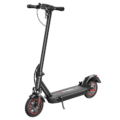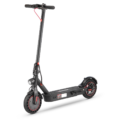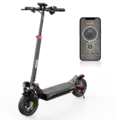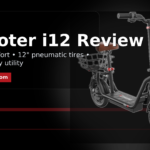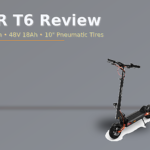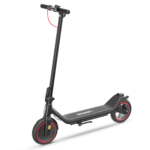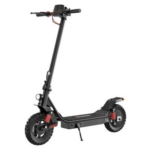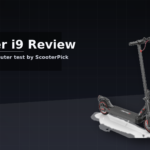- Home
- Scooters
- Electric Scooters
- iScooter F2
iScooter F2
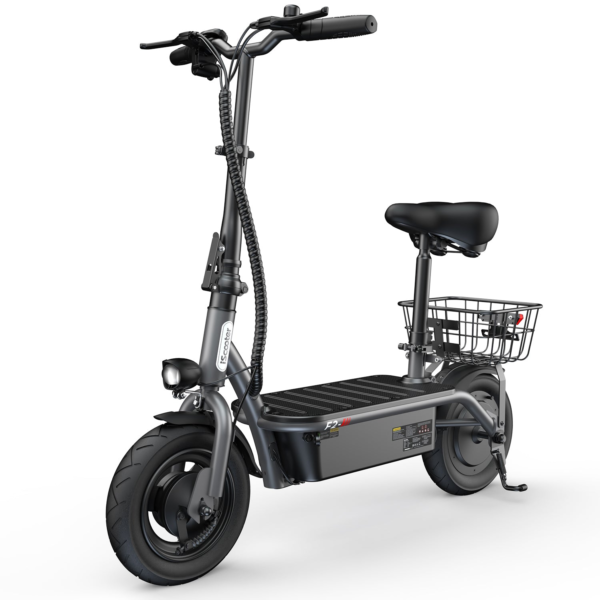

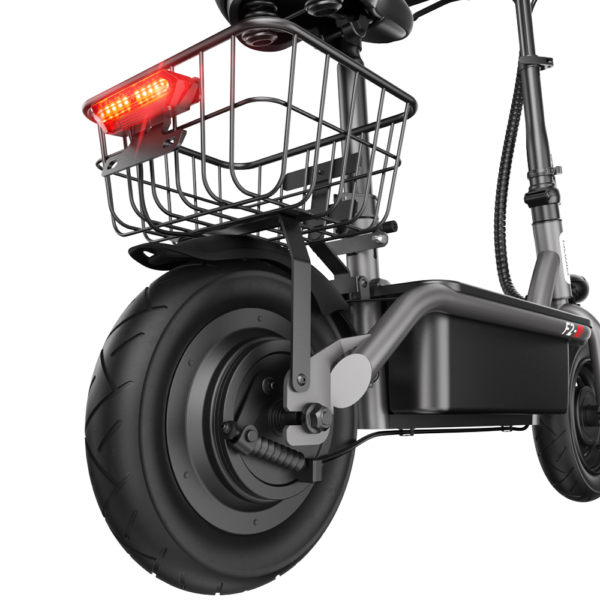
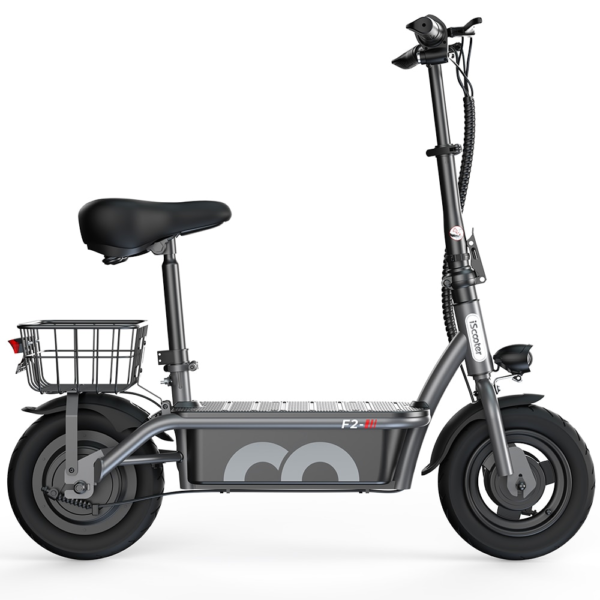
- Battery Range: 21 miles (25–30 km)
- Top Speed: 19 mph (30 km/h)
- Motor Power: 500 W rear hub
- Weight Capacity: 264 lb (120 kg)
- Charging Time: ~5–6 h
- Scooter Weight: 38.6 lb (17.5 kg)
PROS
- 10″ air tires for grip/comfort
- Dual disc braking
- RWD traction
- Quick fold and compact size
- Great value for short commutes
CONS
- No listed suspension
- Range varies with hills/temp
- Air tires need pressure checks
- IP rating not listed

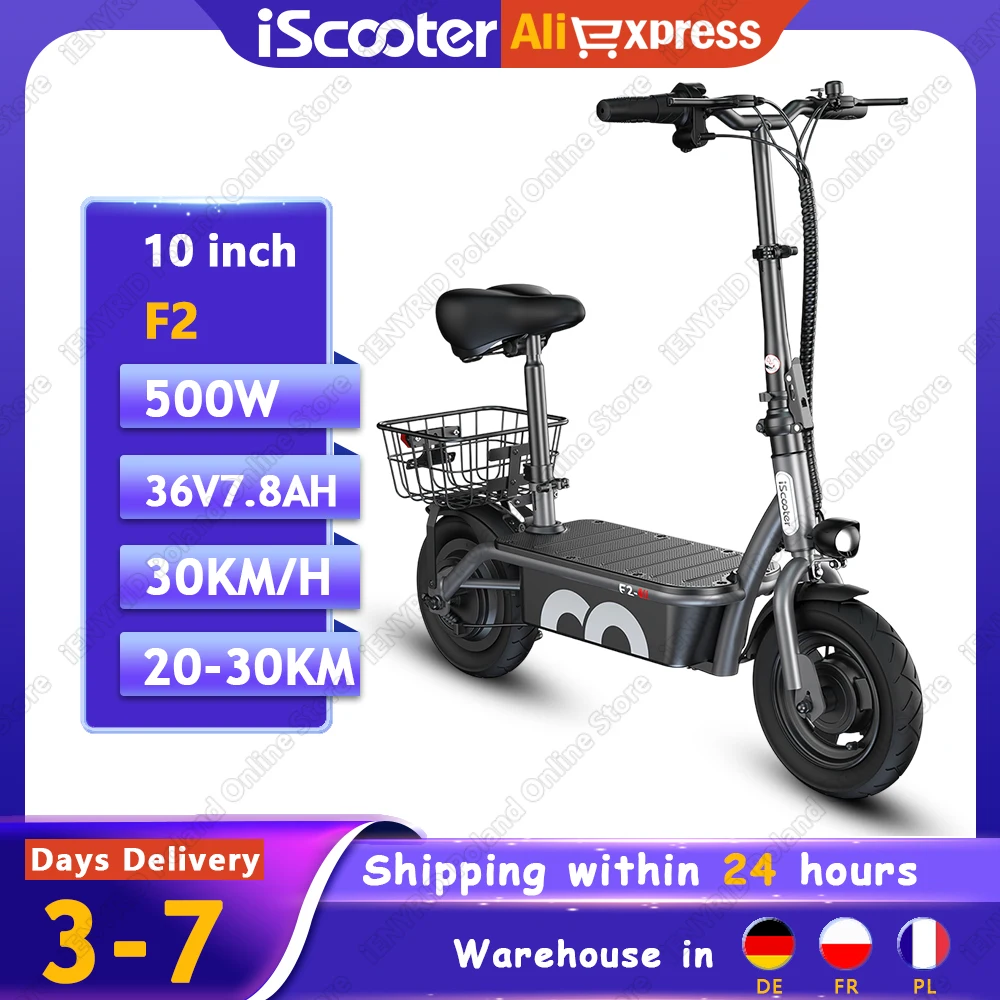


Table of contents
- What Is the iScooter F2?
- How the iScooter F2 Works
- Key Specifications
- Design & Build Quality
- Performance Fundamentals
- Battery, Range & Efficiency
- Ride Quality & Comfort
- Braking & Safety Features
- Portability & Daily Usability
- Maintenance & Care
- Weather & Seasonal Considerations
- iScooter F2 vs Alternatives
- Who the iScooter F2 Is (and Isn’t) For
- FAQs
- Glossary
- Final Setup & Riding Checklist
- Summary
The iScooter F2 is a compact, entry-level commuter scooter designed for short urban trips, campus rides, and first-mile/last-mile hops. It prioritizes simplicity and predictable handling over sheer power, making it a friendly option for new riders and anyone who wants a low-maintenance way to move through city streets. Because it’s light and folds quickly, it also suits multi-modal routines that mix scooters, trains, and office elevators. If you’re weighing a step-up class for more muscle, the Segway Ninebot F2 Pro is a natural comparison point, while the iScooter F2 focuses on portability and straightforward daily use.
What Is the iScooter F2?
At its core, the iScooter F2 is a straightforward electric kick scooter with a brushless hub motor, a 36-volt battery, a simple bar-mounted throttle and brake controls, and a quick-fold stem. It’s built for paved paths and city streets, not off-road trails. Moreover, the frame and cockpit are intentionally minimal, so you don’t have to think about settings or complex service. You unfold it, power it on, choose a speed mode, and ride. These specifications target urban convenience rather than raw speed.
Furthermore, the platform sits in the budget-commuter class, where the emphasis is on reliable everyday performance instead of extreme numbers. With an approachable top speed and a single-disc/electronic-assist brake setup, the F2 aims to keep riders in control in common urban scenarios: rolling starts, stop-and-go traffic, and curb cuts. In other words, it’s tuned for predictable responses rather than flashy claims.
How the iScooter F2 Works
Motor & Controller. The scooter uses a brushless DC hub motor built into one wheel. The controller—an electronic “brain”—meters power to the motor based on your throttle input. Think of the controller like a faucet: twist the throttle and the controller “opens” electrical flow to spin the motor harder; ease off and it “closes” flow to reduce torque. Consequently, smooth inputs translate to smooth acceleration.
Battery & Power Delivery. A 36 V lithium-ion battery supplies energy to the controller. Voltage provides the “electrical push,” while capacity (measured in amp-hours and watt-hours) determines how far you can ride before recharging. During acceleration, the controller pulls current in short bursts; during steady cruising, it sips. Therefore, gentle launches typically stretch range further than repeated full-blast starts.
Throttle Behavior. A thumb or trigger throttle on the handlebar sends a signal to the controller. Most commuters appreciate the thumb layout because it’s easy to modulate while gripping the bar. As a result, you’ll feel a gentle initial surge, then a steadier pull as the scooter reaches its cruising speed. This tuning helps newer riders keep balance during starts.
Brakes & Regen. Braking combines a mechanical disc brake and an electronic assist (often called E-ABS). When you squeeze the lever, the disc brake slows the wheel while the controller applies motor drag. In practice, this dual action increases stability and reduces stopping distance without requiring heavy lever effort.
Lighting & Display. An integrated LED headlight and tail/brake light help you remain visible. Meanwhile, a central display shows speed, battery, and mode. Because it’s a commuter model, the layout favors quick readability over deep customization.
Key Specifications
General
- Product Type: Electric kick scooter
- Intended Use: Urban commuting and short trips
- Rider Height Range: Typical adult range
- Max Rider Weight: 264 lb (120 kg)
Performance & Power
- Motor: 350 W brushless hub (nominal)
- Top Speed (rated): 15.5 mph (25 km/h)
- Speed Modes: 3 selectable modes
- Hill Grade (typical urban ramps): ~7–10% with rider-weight dependence
Battery, Charging & Electrical
- Battery Voltage: 36 V
- Battery Capacity: 7.5 Ah (≈270 Wh)
- Charger Output: 42 V; ~1.5–2.0 A
- Typical Charge Time: ~4–6 hours
- Battery Type: Lithium-ion, protected BMS
- Regenerative Braking (E-ABS): Yes
Build & Dimensions
- Tires: 8.5 in (216 mm), low-maintenance honeycomb/solid design
- Suspension: None (tire compliance provides the give)
- Unfolded Dimensions (approx.): 42.5 × 16.9 × 45.7 in (1080 × 430 × 1160 mm)
- Folded Dimensions (approx.): 42.5 × 16.9 × 19.3 in (1080 × 430 × 490 mm)
- Weight: ~29–31 lb (≈13–14 kg)
- Deck Height (to ground): Typical commuter height for clearance
Safety & Control
- Brakes: Rear mechanical disc + electronic assist (E-ABS)
- Lighting: Front LED headlight; rear light with brake illumination
- Reflectors: Side and rear reflectors for visibility
- IP Rating: Not specified
- Bell: Integrated
Features & Extras
- Cruise Control: Yes (speed-hold after sustained throttle)
- Display: Center LED (speed, battery, mode)
- Quick-fold Stem: Yes, single-action latch
- Kickstand: Side-mount
- App Connectivity: Not specified
Warranty & Compliance
- Warranty: Limited manufacturer warranty (term varies by region)
- Compliance: CE/RoHS and regional electrical safety standards
Design & Build Quality
Frame & Geometry. The F2’s frame uses a conventional commuter geometry: a straight stem, a flat deck, and a compact wheelbase. This layout is intentionally conservative because it yields predictable handling at the scooter’s rated speeds. Additionally, the deck height remains moderate for ground clearance, yet it doesn’t force an awkward ankle angle during long rides.
Deck & Standing Room. The deck provides enough length for a staggered stance (lead foot angled, rear foot perpendicular). A grippy surface helps your shoes stay planted over bumps. However, because the tires are solid, some road buzz reaches the deck. Even so, the stiffness also makes steering inputs crisp and direct.
Stem & Latch. The stem uses a single-action folding latch with a safety catch. Once you learn the motion, fold/unfold is quick—useful when you’re catching a train or storing the scooter beside a desk. Moreover, the stem diameter and clamp interface are sized to limit flex at commuter speeds; you may feel some give over rough patches, but it’s within expectations for this class.
Cockpit & Controls. The cockpit keeps it simple: throttle on one side, brake lever on the other, a central display, and a bell. Buttons are tactile, so mode changes don’t require long glances. Likewise, grips are basic rubber with a moderate profile to reduce hand fatigue.
Fit & Finish. The finish is matte and resists fingerprints. Cable routing is tidy, and the headlight sits high enough to cast useful light forward rather than only in front of the wheel. Notably, fasteners are standard metric hex, which makes routine checks and adjustments straightforward.
Performance Fundamentals
Acceleration Feel. The controller’s low-to-mid throttle mapping favors smoothness. From a dead stop, the scooter eases into motion rather than jolting forward. As a result, new riders learn balance more easily, and experienced riders get consistent starts at intersections.
Cruising & Stability. At a steady 12–15 mph (19–25 km/h), the chassis tracks straight with minimal steering corrections. Solid tires add a hint of road texture, yet they also keep the steering precise. On settled pavement, the scooter feels composed. On brick or uneven concrete, unlock your knees and let your legs act as suspension. Consequently, the ride remains controlled even when the surface gets busy.
Hill-Climb Behavior (~7–10%). On short, moderate grades, the F2 will slow but keep moving if you lean forward and maintain throttle. As with all entry-level commuters, rider weight makes a noticeable difference. A lighter rider on a 7% ramp will experience steady, patient climbing; a heavier rider on a 10% grade will see speed drop into the single digits. Therefore, planning a small rolling start before a hill helps.
Top-Speed Stability. Approaching its rated top speed, the scooter remains predictable. Because geometry and tire stiffness resist oscillations, you don’t fight the bars. If you encounter choppy surfaces at maximum mode, easing slightly off the throttle smooths the ride and preserves control. In short, composure is prioritized over peak pace.
Battery, Range & Efficiency
Rated vs Real-World. The 36 V, ~270 Wh battery provides commuting range suitable for daily errands and short commutes. Real-world range varies with rider weight, incline, stop frequency, wind, temperature, and tire condition. Lighter riders on flat routes can stretch distance; heavier riders on hilly terrain will cover less. Consequently, planning with a buffer is wise.
Riding Style Matters. Smooth throttle use and anticipating stops extend range. Hard launches and frequent full-power bursts spend watt-hours quickly. Therefore, cruising a few mph below top speed often adds a meaningful margin to your return distance.
Temperature Effects. Cold weather temporarily reduces lithium-ion capacity, while heat accelerates battery aging. In winter, expect shorter rides per charge; in summer heat waves, give the scooter time to cool before charging. As a result, seasonal habits pay off in both range and longevity.
Charging Best Practices.
- Let the scooter rest for ~15–30 minutes after hard rides before charging.
- Avoid 0% battery when possible; re-charge around 20–30% for longevity.
- Unplug shortly after reaching full to reduce heat soak.
- Store around 50–60% state-of-charge if you won’t ride for several weeks.
Efficiency Tips.
- Keep the deck area clear; dangling bags can increase drag.
- Use a steady pace in Mode 2 for a range-friendly balance of speed and battery life.
- Check tire condition; fresh solid tires maintain rolling efficiency.
- Additionally, avoid long uphill sprints right before you need to return.
Ride Quality & Comfort
Tire Type & Feel. The 8.5-inch honeycomb (solid) tires eliminate flats and daily pressure checks. You trade some cushion for this reliability, so the ride is firmer than pneumatic setups. On smooth tarmac, the feel is pleasantly direct. On coarse asphalt or pavers, bend your knees and ride light on the feet to absorb buzz. Consequently, posture plays an outsized role in comfort.
No Suspension, No Fuss. Without springs or shocks to tune, the F2 reduces maintenance and keeps weight down. The frame relies on tire compliance and rider posture for comfort. Small road seams are noticeable but not jarring; bigger cuts or potholes should be avoided, as with any commuter in this segment. Still, the simplicity here reinforces everyday reliability.
Ergonomics. Bar height and deck geometry suit average adult riders. If you’re taller, a slightly bent-arm stance helps steering precision and reduces neck strain. Likewise, the deck’s grip and width support shoulder-width foot placement for longer trips.
Stem Flex & Confidence. Mild stem flex shows up on rougher surfaces or during hard braking. It’s within normal limits for a commuter. However, the benefit is a touch of vibration filtering without feeling vague at speed.
Braking & Safety Features
Brake Setup & Feel. The rear mechanical disc delivers the main stopping force, while the electronic assist adds controlled drag at the motor. Initial lever pull is light; as you squeeze further, bite firms up. Braking from cruising speeds is stable, and the scooter tracks straight with minimal fork twist. Therefore, practicing progressive lever input builds confidence quickly.
Technique Tips.
- Shift your weight slightly rearward under hard braking to keep the rear wheel planted.
- Squeeze the lever progressively; avoid grabbing a handful all at once.
- Keep your knees soft; stiff legs transmit bumps into the bars during stops.
- Additionally, test brake response in an empty lot after any adjustment.
Lighting & Visibility. The headlight is angled for useful forward illumination. The rear light brightens on brake input, signaling to those behind you. Side reflectors add cross-traffic visibility at intersections. Importantly, reflective clothing at night further improves conspicuity.
Water Resistance. Because an official IP rating isn’t specified, treat wet rides conservatively. Light splashes happen in cities, but prolonged exposure or submersion risks damage. After damp rides, wipe the scooter dry and let moisture evaporate before charging.
Portability & Daily Usability
Weight & Carrying. At roughly 29–31 lb (≈13–14 kg), the F2 carries with one hand up a flight of stairs if you take your time. For routine inside-to-outside moves, it’s easy enough to manage without bumping into door frames. Consequently, it fits multi-modal routines without much fuss.
Folding & Latch. The single-action latch with a safety catch speeds up transitions. When folded, the scooter’s stem can be used as a handle. The folded footprint slides under desks and behind office chairs. Therefore, storage in tight spaces is straightforward.
Storage & Security. Indoors is always best for battery health and theft prevention. If you leave the scooter in a communal area, a compact U-lock through the rear triangle or a stout cable around a fixed object adds deterrence. Avoid leaving it on a hot balcony or in a freezing trunk for long stretches. In addition, label your charger to avoid mix-ups at shared offices.
Daily Routines That Work.
- Charge at home; ride in Mode 2 to work and back with margin.
- Keep a microfiber cloth near your door to wipe dust or drizzle.
- Do a 10-second pre-ride check: latch, lever feel, lights, and tire condition.
- Finally, schedule a quick monthly brake inspection to stay ahead of wear.
Maintenance & Care
Quick Schedule (Simple & Effective).
- Before each ride (10 seconds): Check fold latch locked, brake lever firm, lights on, no loose items near the front wheel.
- Weekly (5 minutes): Inspect fasteners (stem clamp, wheel nuts), wipe dust off the deck and display, test the bell.
- Monthly (10–15 minutes): Check brake pad wear, cable tension, and rotor alignment; clean reflectors and headlight lens.
- Quarterly: Inspect tire surfaces for cuts or embedded debris; ensure the kickstand bolt is tight; examine charging port cap condition.
- Annually: Consider a professional once-over if you ride daily.
Brake Adjustment. If lever travel increases, tension the cable slightly at the caliper barrel adjuster, then re-center the caliper if you hear rubbing. Spin the wheel after adjustments to confirm clearance and firm bite. Additionally, verify that the rotor is not warped by watching for side-to-side wobble.
Fasteners & Threads. Use the correct hex size to avoid rounding heads. If a bolt repeatedly loosens, a dab of medium-strength thread locker (on clean threads) helps. Conversely, avoid over-tightening; stripped threads are harder to fix than a bolt that occasionally needs snugging.
Firmware/App Habits. If app connectivity is available for your unit, keep firmware current. Update only when the scooter is fully charged and stationary, and follow on-screen prompts carefully. Otherwise, skip optional updates right before a commute.
Battery Storage. For breaks longer than a week, store at room temperature around half charge. Top up every 1–2 months if it sits unused, especially in cold seasons. Consequently, long-term health improves and sudden range drops are less likely.
Weather & Seasonal Considerations
Rain. With no published IP rating, ride conservatively if caught in drizzle and avoid deep puddles. Wet braking distances increase on any scooter; start slowing earlier and keep your inputs smooth. After you get inside, dry the scooter and let residual moisture evaporate before charging.
Cold. Expect reduced range in winter. Start with a warm battery if possible and plan shorter trips. Because cold raises internal resistance, you may notice softer acceleration at the same throttle. Therefore, allow extra time for commutes on very cold mornings.
Heat. Hot weather elevates battery and controller temperatures. Parking in shade helps. After a spirited ride in high heat, let the scooter cool briefly before charging. In addition, avoid leaving the scooter in a closed car on summer afternoons.
Wind. Headwinds increase power draw and reduce range; tailwinds do the opposite. If you ride an out-and-back route, conserve energy on the outbound leg when facing a steady breeze. Consequently, you’ll maintain a buffer for the return trip.
Road Surface. Painted lines, metal plates, and wet leaves reduce traction. Roll straight across painted crosswalks in the rain and avoid sudden steering changes on slick patches. Likewise, slow slightly before brick or cobblestone segments to keep the ride composed.
iScooter F2 vs Alternatives
Where It Excels. The iScooter F2 leans into everyday practicality: low maintenance, no tire inflation, quick folding, and predictable controls. It’s ideal for short commutes, campus rides, and errands where convenience matters most. Riders who value “grab-and-go” over tinkering tend to like it. As a result, the F2 fits many daily routines without ceremony.
Commuter Class Peers. Compared with other entry-level commuters, the F2’s solid tires trade a bit of cushion for freedom from punctures. If you ride on clean, smooth bike lanes, that’s a win. If your route includes broken pavement or cobblestones, a pneumatic-tire model may feel plusher but will demand occasional pressure checks and flat repairs. On balance, the choice is comfort versus maintenance.
Performance Class Scooters. Stepping up to mid-tier or performance commuters adds stronger acceleration, higher top speeds, and bigger batteries—but also more weight and cost. If you often tackle steep hills or carry heavy loads, a higher-power unit can be worth it. Otherwise, for predominantly flat, short hops, the F2’s balance of weight and simplicity remains attractive.
Off-Road/Terrain Models. Trail-oriented scooters bring suspension, knobby tires, and high ground clearance. They are heavier and less convenient to carry. Unless you specifically need off-pavement capability, a compact commuter like the F2 is the better urban tool. Therefore, think honestly about your terrain before upgrading categories.
Who the iScooter F2 Is (and Isn’t) For
Great For
- New riders who want a gentle learning curve.
- Students navigating campuses and nearby neighborhoods.
- Short-distance commuters on flat or rolling terrain.
- Multi-modal travelers who fold, carry, and store the scooter often.
- Maintenance-averse riders who prefer solid tires and simple checks.
Think Twice If
- Your route has long, steep hills or you routinely carry heavy cargo.
- You demand maximum comfort over rough surfaces; pneumatic tires or suspension may suit you better.
- You want high speed beyond standard urban limits; step up a class.
- Additionally, if you ride frequently in heavy rain, seek a model with a published water-resistance rating.
FAQs
- How fast does it go?
The F2’s rated top speed is about 15.5 mph (25 km/h), which aligns with common urban speed limits for entry-level commuters. As always, ride within local laws and conditions. - What range can I expect per charge?
Real-world range depends on rider weight, terrain, temperature, and speed. The battery capacity (~270 Wh) supports typical short-to-moderate commutes when ridden smoothly. For longer days, plan a mid-day top-up. - Can it climb hills?
Yes, on moderate grades around 7–10%, but speed will drop more for heavier riders or longer climbs. A small rolling start helps on steeper ramps. Additionally, keep your stance forward to maintain traction. - Does it have cruise control?
Yes. After holding a steady throttle for several seconds, the scooter can maintain that speed until you brake or blip the throttle. Consequently, long straight sections feel less tiring. - Is it okay to ride in the rain?
Because there’s no official IP rating published, ride conservatively if caught in light rain and avoid standing water. Dry the scooter after wet rides, and let it sit before charging. - What makes this an “iScooter F2 overview” rather than a hands-on test?
This overview explains how the system works, organizes the official spec set into a practical guide, and offers rider-focused tips for setup, safety, and care. It does not include instrumented performance testing. - How often should I service the brakes?
Check lever feel weekly and inspect pads monthly. If you feel longer lever travel or hear rubbing, adjust cable tension and re-center the caliper. Afterwards, test in a safe area.
Glossary
- Ah (Amp-hours): A measure of battery capacity—how much current a battery can supply over time.
- Wh (Watt-hours): Voltage × amp-hours; a practical measure of usable energy and range potential.
- Brushless Hub Motor: An electric motor integrated into the wheel, efficient and low-maintenance.
- Controller: The electronic module that meters current from the battery to the motor based on throttle input.
- Regen (Regenerative Braking): Electronic braking that uses the motor to create drag and recapture a little energy.
- E-ABS: Electronic anti-lock behavior that modulates motor braking to improve stability under deceleration.
- BMS (Battery Management System): Protects the battery from over-charge, over-discharge, and short circuits.
- IP Rating: Ingress Protection against dust and water; “Not specified” means you should ride cautiously in wet conditions.
- Honeycomb/Solid Tire: Puncture-proof tire with internal cavities for compliance; firmer than pneumatic tires.
- Stem Flex: Slight elastic movement in the handlebar stem under load; normal in commuter scooters.
- Speed Mode: Software-limited speed ranges that balance acceleration, top speed, and efficiency.
- Deck: The standing platform; grip and width affect comfort and control.
- Sine-Wave/Square-Wave Controller: Two power-delivery styles; commuter models often use simple square-wave units.
- State of Charge (SoC): The current battery percentage; mid-range SoC is best for storage longevity.
- Watt (W): Unit of power; higher wattage means stronger acceleration and hill performance.
Final Setup & Riding Checklist
- Pre-Ride: Check latch, lights, lever feel, and tire surfaces.
- Route Planning: Favor smooth bike lanes and predictable surfaces.
- Braking Practice: Try a few controlled stops in an empty lot to learn lever feel.
- Throttle Discipline: Use steady inputs; it’s kinder to range and traction.
- Post-Ride: Let the scooter cool briefly, then charge in a ventilated area.
- Monthly: Inspect pads, fasteners, and reflectors; make small adjustments early.
Summary
The iScooter F2 is a friendly, no-nonsense commuter built around reliability and ease of use. Its solid tires remove flat anxiety, its fold is fast, and its controls are intuitive. While it won’t out-muscle performance scooters on steep hills, it shines where most people actually ride—flat and rolling city terrain at everyday speeds. Ultimately, if you want simple transportation with light maintenance and predictable manners, this compact package lines up well. Its specifications favor everyday portability over complexity, and that balance is intentional.
Specifications
General
| Model The Model specifies the exact version or name of the scooter. It helps identify its unique design, features, and specifications within the manufacturer’s product line. Knowing the model makes it easier to compare options, find compatible accessories, or look up support information. | F2 |
| Brand The Brand identifies the manufacturer or company that designs and produces the scooter. A trusted brand is a sign of quality, reliability, and good customer support. Well-known brands often have higher standards for safety, performance, and after-sales service, giving you more confidence in your purchase. | iScooter |
| Release Date The Release Date indicates when the scooter model was officially launched on the market. This helps you know how current the design, technology, and features are. A newer release date often means updated components, improved performance, and the latest safety or smart features. | 17 November 2025 |
| Recommended Age Recommended Age indicates the minimum age range that the scooter is designed for, based on safety, size, and ease of use. Following the recommended age helps ensure that riders can handle the scooter’s speed, weight, and controls comfortably and safely. Always check local laws and use protective gear, especially for younger riders. | Recommended 14+ |
Performance & Power
| Motor Power (Wattage) What it means: The motor power, measured in watts (W), shows how strong the scooter’s electric motor is. Why it matters: Higher wattage usually means better acceleration, more torque, and improved performance on hills or rough terrain. For example, a 250W motor is good for flat city roads and light riders, while a 500W or 1000W motor provides more power for faster speeds or climbing steep inclines. | 500 W rear hub motor |
| Top Speed The Top Speed indicates the maximum speed that the scooter can reach under optimal conditions. It’s usually measured on level ground with a fully charged battery and an average rider weight. A higher top speed allows you to travel longer distances faster, but always ensure you ride within legal speed limits and your personal comfort zone for safety. | 19 mph (30 km/h) |
| Battery Capacity Battery Capacity refers to the total amount of energy the scooter’s battery can store, usually measured in ampere-hours (Ah) or watt-hours (Wh). A higher battery capacity means you can ride longer distances on a single charge, reducing the need for frequent recharging. Keep in mind that actual range can vary depending on rider weight, terrain, speed, and weather conditions. | 36 V 7.8 Ah |
| Estimated Range per Charge The Estimated Range per Charge indicates the average distance the scooter can travel on a single full battery charge. This range is calculated under optimal conditions, such as flat terrain, moderate speed, and average rider weight. Real-world range may vary depending on riding style, terrain, weather, and load. A longer range means fewer recharges and greater freedom for longer trips. | 21 miles (25–30 km) |
| Hill Climb Ability Hill Climb Ability describes the maximum incline or slope that the scooter can handle while maintaining stable performance. It’s typically expressed as a percentage or in degrees. A higher hill climb rating means the scooter can tackle steeper hills without losing too much speed or power. Actual climbing performance may vary based on rider weight, battery charge, and terrain conditions. | 15% grade |
| Drive System The Drive System refers to how power from the motor is delivered to the wheels. Electric scooters typically use either a hub motor (directly integrated into the wheel) or a chain/belt drive system. A high-quality drive system ensures smooth acceleration, efficient power transfer, and low maintenance. The choice of drive system affects performance, noise level, and overall ride experience. | Rear wheel drive (RWD) |
Charging & Electrical
| Charging Time Charging Time indicates how long it takes to fully recharge the scooter’s battery from empty to 100% using the standard charger provided. Faster charging means less downtime and more time on the road. Actual charging time may vary slightly depending on battery capacity, charger output, and environmental conditions. | Approx. 5–6 hours |
| Battery Type Battery Type refers to the specific technology used in the scooter’s battery, which affects performance, lifespan, weight, and charging time. Most modern electric scooters use high-quality lithium-ion (Li-ion) batteries because they offer a good balance of energy density, durability, and low maintenance. A reliable battery type ensures consistent power delivery and longer riding ranges. | Lithium-ion pack |
| Removable Battery A Removable Battery means the battery pack can be easily detached from the scooter for convenient charging and replacement. This feature allows you to charge the battery separately, swap it with a spare for extended range, or securely store it indoors in extreme weather. Removable batteries add flexibility and make it easier to keep your scooter powered up wherever you are. | Non-removable internal battery (fixed pack) |
| Regenerative Braking Regenerative Braking is an energy-saving feature that converts some of the energy normally lost during braking back into battery power. When you slow down or brake, the motor works in reverse to generate electricity, which helps extend the scooter’s range and improves overall efficiency. This system also reduces wear on traditional brake components, leading to lower maintenance over time. | Not specified (regen not listed) |
| Lighting Lighting refers to the built-in front and rear lights that enhance visibility and safety when riding in low-light conditions or at night. Good lighting helps you see the road ahead and ensures that other road users can see you. Many scooters include LED headlights, taillights, and sometimes brake lights or side reflectors for added safety and compliance with local traffic regulations. | Front white light + red tail light |
Build & Dimensions
| Scooter Weight Scooter Weight refers to the total weight of the scooter when fully assembled, including the battery. This affects how easy it is to carry, lift, and store the scooter when not in use. A lighter scooter is more portable and convenient for commuting, especially if you need to carry it upstairs or onto public transport. Keep in mind that a sturdy frame and quality components may add to the weight but also contribute to better durability and ride stability. | 38.6 lb (17.5 kg) |
| Maximum Rider Weight Maximum Rider Weight indicates the highest rider weight that the scooter is designed to safely support while maintaining optimal performance and stability. Staying within this limit helps ensure reliable acceleration, braking, and climbing ability, and it protects the frame, suspension, and motor from excessive strain. Exceeding the recommended limit may reduce performance and increase wear on components. | 264 lb (120 kg) |
| Deck Size Deck Size refers to the dimensions of the scooter’s standing platform. A wider and longer deck provides more foot space, allowing you to stand comfortably and adjust your stance while riding. A well-sized deck improves balance and stability, especially on longer rides or at higher speeds. Compact decks, on the other hand, help keep the scooter lightweight and portable. | Compact deck; stable stance |
| Handlebar Height Handlebar Height refers to the distance from the deck to the handlebars, which affects your riding posture and comfort. An appropriate handlebar height helps you maintain good balance, reduces strain on your back and arms, and makes steering more comfortable. Some scooters have adjustable handlebars to fit riders of different heights, while others have a fixed height for a streamlined design. | Fixed bar height |
| Folding Mechanism The Folding Mechanism describes how easily and securely the scooter can be folded for carrying and storage. A well-designed folding system lets you quickly collapse the scooter into a compact size, making it convenient to transport on public transit, store under a desk, or fit into a car trunk. Look for sturdy latches and safety locks to ensure the scooter stays firmly in place when folded or unfolded. | Quick fold |
| Dimensions Folded Dimensions indicate the size of the scooter when it’s fully folded. This measurement shows how much space the scooter will take up when stored or carried, making it easier to check if it will fit in your car trunk, under a desk, or in a closet. Compact folded dimensions are ideal for commuters who need to bring their scooter on public transport or store it in tight spaces. | Unfolded 40.6 × 21.9 × 37.4 in; folded 40.6 × 21.9 × 24 in |
| Material Material refers to the primary construction materials used for the scooter’s frame and key components. High-quality materials like aircraft-grade aluminum, reinforced steel, or durable composites provide strength, stability, and a lighter overall weight. A sturdy material ensures the scooter can handle daily wear and tear while maintaining safety and performance. | Not specified |
Safety & Control
| Brake Type(s) Brake Type(s) describe the braking systems the scooter uses to help you slow down or stop safely. Common brake types include mechanical brakes (like drum or disc brakes), electronic brakes, and foot brakes. Many scooters combine multiple braking systems for added safety and shorter stopping distances. The type and quality of brakes affect your control, especially when riding at higher speeds or on slopes. | Dual disc (mechanical) |
| Suspension Suspension refers to the system that absorbs shocks and vibrations while riding, providing a smoother and more comfortable ride over uneven or rough surfaces. Scooters may have front suspension, rear suspension, or dual suspension for better shock absorption and stability. Good suspension helps reduce rider fatigue and improves control, especially when riding on bumpy roads or off-road paths. | None listed |
| Tire Type Tire Type refers to the kind of tires the scooter uses, which directly affects ride comfort, traction, and maintenance. Common types include solid (airless) tires, pneumatic (air-filled) tires, or hybrid options. Pneumatic tires offer better shock absorption and a smoother ride on rough surfaces, while solid tires are puncture-proof and require less upkeep. The right tire type helps ensure safe handling and a comfortable ride in different conditions. | Pneumatic tires |
| Tire Size Tire Size indicates the diameter and width of the scooter’s tires, which affect ride comfort, stability, and how well the scooter handles different terrains. Larger tires generally offer better shock absorption and a smoother ride over bumps and rough surfaces, while smaller tires keep the scooter lighter and more portable. Choosing the right tire size helps ensure a balance between agility and comfort. | 10-inch |
| Kickstand The Kickstand is a built-in stand that allows you to park your scooter upright when it’s not in use. A sturdy kickstand keeps the scooter stable and prevents it from tipping over, protecting it from scratches and damage. It also makes storing and accessing your scooter more convenient, whether you’re at home, work, or on the go. | Side kickstand |
| Water Resistance Rating Water Resistance Rating indicates how well the scooter is protected against water and moisture, usually shown as an IP (Ingress Protection) rating. This rating helps you understand whether the scooter can handle light rain, splashes, or wet roads without damage. While most scooters are not fully waterproof, a good water resistance rating adds peace of mind when riding in changing weather conditions. Always avoid deep puddles or submerging the scooter to protect its electrical components. | Not specified |
Features & Extras
| Display/Console The Display (or Console) shows important real-time information about your ride, helping you monitor your scooter’s status at a glance. Typical displays show speed, battery level, distance traveled, and riding mode. Some models also include additional features like Bluetooth connectivity, app integration, or backlighting for better visibility at night. A clear and easy-to-read display enhances safety and convenience on every trip. | LCD screen (battery/alerts; screen referenced in FAQ). |
| Ride Modes Ride Modes refer to the different speed and power settings you can choose to match your riding style or road conditions. Common modes include eco for maximum range and energy efficiency, standard for everyday balance, and sport or turbo for higher speed and stronger acceleration. Switching between ride modes allows you to customize performance, conserve battery, and ride safely in various environments. | 2 riding modes: Low (EU 15 km/h; NA ~9 mph/14 km/h) and High (EU 25 km/h; NA ~19 mph/30 km/h); switch by twisting throttle twice while holding brake (per manual). |
| Smart App Connectivity Smart App Connectivity lets you pair your scooter with a dedicated mobile app via Bluetooth. Using the app, you can monitor real-time ride stats like speed, battery level, and range, adjust settings such as ride modes or cruise control, lock the scooter for added security, and sometimes receive firmware updates. This feature adds convenience and allows you to personalize your riding experience right from your smartphone. | Minibot app referenced in FAQ for Zero Start setting (operation primarily via key). |
| Anti-Theft System The Anti-Theft System helps protect your scooter from unauthorized use or theft. This feature can include built-in alarms, electronic motor locks, GPS tracking, or remote locking through a mobile app. A good anti-theft system provides peace of mind when parking your scooter in public spaces, adding an extra layer of security to safeguard your investment. | Keyed ignition (insert/turn key to power on; second click toggles lights). |
| Cruise Control Cruise Control allows you to maintain a steady speed without continuously holding the throttle. This feature makes longer rides more comfortable by reducing hand fatigue and providing a smoother, more relaxed riding experience — especially on flat, open roads or bike lanes. For safety, cruise control can usually be easily activated or deactivated while riding. | Cruise control not specified in the official manual/page. |
| Accessories Included Accessories Included lists the additional items that come with the scooter to enhance your riding experience and convenience. Common accessories may include a charger, kickstand, bell, lights, phone holder, or carrying strap. These extras add value by making your scooter safer, easier to use, and ready to ride straight out of the box. | In the box: F2 scooter, seat, spare inner tube, rear basket & mounting hardware, wrench kit, user manual & safety instructions, charger, ignition key. |
Warranty & Compliance
| Warranty Period The Warranty Period indicates how long the manufacturer guarantees the scooter against defects in materials and workmanship under normal use. A good warranty provides peace of mind, showing the brand’s confidence in its product quality. Always check what parts are covered, such as the frame, battery, and motor, and follow the maintenance guidelines to keep your warranty valid. | 12 months (region-dependent) |
| Certifications Certifications confirm that the scooter meets specific safety, quality, and environmental standards set by recognized organizations or regulatory bodies. Common certifications may include CE, RoHS, UL, or other local compliance marks, depending on your region. These certifications ensure that the scooter is manufactured to high standards and is safe and legal to use in your country. | Local micromobility compliance |
Price Comparison






